BIOSTATISTICS OVERALL JUNE 20241234567.pptx
- 2. What is Statistics? Statistics is concerned with the collection, analysis and interpretation of data collected from groups of individuals. Individuals: people, households, clinic visits, regions, blood slides, mosquitoes, etc., Data lab. measurements (serological titres, bacteria counts) (age, sex, area of residence, WT,HT)
- 3. Statistics is the science concerned with developing and studying methods for: collecting, analysing, interpreting, and presenting data. Biostatistics is the application of statistical principles in the fields of medicine, public health, and biology
- 4. Studying biostatistics useful for? • The design and analysis of research studies. • Describing and summarizing the data we have. • Analysing data to formulate scientific evidence regarding a specific idea. • To conclude if an observation is of real significance or just due to chance. • To understand and evaluate published scientific research papers. • It is a basic part of some fields as clinical trials and epidemiological studies.
- 5. The statistical analysis journey: The statistical analysis journey goes through the following steps: • Transforming the research idea into a research question. • Choosing the proper study design and selecting a suitable sample. • Performing the study and collecting data. • Analysing data (using the appropriate statistical method). • Getting and interpreting the p- value. • Reaching a conclusion (answer) regarding the research question
- 6. Study Design Descriptive inferential or inductive Areas of statistics
- 7. Types of variables Variable is any type of observation made on an individual A qualitative variable is one which takes values that are not numerical, and can be (1) Nominal which have no natural ordering e.g. sex = male, female. (2) Ordinal which have a natural ordering e.g. physical activity 'inactive’, 'fairly active‘, 'very active'. (3) Ranked which have some order or relative position e.g Birth order 1,2,...10.
- 8. A quantitative variable is one for which the resulting observations can be measured because they possess natural order or ranking. Discrete It is a quantitative variable which can only take a number of distinct and separated numerical values. e.g. egg counts can take the values 0,1,2,3,........., but not 2.7. Continuous (quantitative) variable is one which can take an uninterrupted set of values, e.g. height could be 87.235 cms, 71.498 cms etc. Types of variables cont.
- 9. Nominal scales A nominal scale is used when the observation refer to unordered or a classification variables. It simply indicates the group to which each subject belongs. Ordinal scales An ordinal scale is one in which the classes do represent an ordered series or relationships. The relationships are expressed in terms of the algebra of inequalities for example a is less than b (a<b) or a is greater than b (a>b). Scale of Measurement
- 10. Scale of Measurement cont. Interval scales zero point is arbitrary, so a value of zero on the scale do not represents zero quantity of the construct being assessed. E.g. the Fahrenheit scale used to measure temperature. Ratio scales have a true zero point. The zero does represent the complete absence of the attribute of interest, Zero length means no length.
- 11. Variable Quantitative Qualitative(Categorical) ContinuousDiscrete Nominal Ordinal Ranked Weight Skinfold thickness Breast milk intake Hb concentration Egg count Bacterial count Episodes of diarrhoe No. of rooms in a house Sex blood group Area of residence Type of admission Survival (yes, no) Infected (yes, no) physical activity Birth order
- 12. Normally distributed variables are common in biological measurements (as height, blood pressure, IQ, …) and have the following characteristics: • Symmetric around the mean. • The mean, median, and mode of a normal distribution are almost equal. • Normal distributions are denser in the center and less dense in the tails (bell shape). •
- 13. 50% of values less than the mean and 50% greater than the mean. • Normal distributions are defined by two parameters, the mean (μ) and the standard deviation (σ). • 68% of the area of a normal distribution is within one standard deviation of the mean. • Approximately 95% of the area of a normal distribution is within two standard deviations of the mean. • Approximately 99.7% of the area of a normal distribution is within three standard deviations of the mean.
- 14. ical: The curve indicates that most of the scores fell in the with relatively few observations on either tale of the distribution ht, height.
- 16. Positively skewed: Most of the values are low with some of the values at the end of the distribution, e.g. income, triceps skin fold measurement.
- 17. Characteristics: 1- The distribution is symmetric about its mean, , that is, the closer values are to the mean the more frequently they occur. Values that are very large or small in relation to the mean occur less frequently. 2- The area under the curve = 1.0, half the area is to the left of the mean and the other half is to the right of the mean. 3- The mean, median and mode are equal The location of a normal distribution depends on the mean . As we change , we change the location of the center of the distribution
- 18. The location of a normal distribution depends on the mean . As we change , we change the location of the center of the distribution. Fig 8: two normal distributions with the equal variance; but different means (µ2 1)
- 19. ape of the distribution depends on the population standard deviation (). flatter the curve, the bigger is . The higher and thinner the curve, the aller is . wo normal distributions with the same mean; but different variances (1 2).
- 24. Numerical outcome variables (outcome is the variable of primary importance in medical investigations) blood pressure antibody levels birth weight and so on Examples of numerical outcomes
- 25. Measures of central tendency n x n 1 i i x Example 8 3 4 5 5 Mean=(8 + 3 + 4 + 5 + 5 )/5=5 Properties • Sum of deviations from the mean =0 (8-5)+(3 -5)+(4 -5)+(5 -5)+(5 –5)=0 3 -2 -1 0 0 • Sensitive to extreme values Mean
- 26. Median Example Median is not sensitive to extreme values mean=14.8 median=8 2 5 8 11 48 For odd number= N+1 2 Even number is mean of N 2 +1 N 2 , 3 1 3 5 1 8 6 In order 1 1 3 3 5 6 8 Half-way value
- 27. Mode Is the most frequent observation 1 2 3 3 8 4 10 15 9 3 Mode=3 For continuous data the mode must be estimated using the formula Mode=Mean-3*(Mean - Median) For grouped data, the modal group is the one which has the highest frequency.
- 28. Comparison of mean,median and mode Mean=Median=Mode for symmetric distribution
- 29. Mean>median>mode for positively skewed distribution
- 30. Mean<median<mode For negatively skewed distribution
- 31. Measures of variation Range Interquartile range Variance Standard deviation Coefficient of variation
- 32. Birth Weight xi 2.10 2.26 2.52 2.63 2.85 2.86 2.88 2.88 2.90 2.94 3.00 3.62 3.71 Deviations 2.10 - 2.86 2.26 - 2.86 2.52 - 2.86 2.63 - 2.86 2.85 - 2.86 2.86 - 2.86 2.88 - 2.86 2.88 - 2.86 2.90 - 2.86 2.94 - 2.86 3.00 - 2.86 3.62 - 2.86 3.71 - 2.86 86 . 2 13 71 . 3 62 . 3 ..... 26 . 2 10 . 2 n x mean i Median Deviations^2 0.5776 0.3600 0.1156 0.0529 0.0001 0 0.0004 0.0004 0.0016 0.0064 0.0196 0.5776 0.7225 x xi 2 x xi 2028 . 0 12 7225 . 0 ..... 5776 . 0 1 ) ( 2 n x x Variance i 450 . 0 2028 . 0 Deviation Standard Variance SD 1249 . 0 13 45 . 0 n SD SE Error Standard % 8 . 15 86 . 2 45 . 0 100 x SD CV variation of t Coefficien Range 2.57 2.97 Interquartile range Example
- 33. Association • Association is the relationship between Nominal or Ordinal variables, e.g. Sex and Education. • Chi- Square ”, (Χ2 ), Distribution used to find association or not • “ Chi- Square ”, (Χ2 ) , Distribution has a table from which we can obtain “Critical” values corresponding to a certain “ Level of Significance” .
- 34. Association • Example : • The table shows the relationship between smoking and lung cancer • H0: no association between lung cancer and smoking. • H1: there is association between lung cancer and smoking. • yes no total smokers 12 (15.5) 13 (9.5) 25 Non- smokers 19 (15.5) 6 (9.5) 25 total 31 19 50
- 35. Association • Chi- Square (Χ2 ) : • (Χ2 ) = Σi n (O – E )2 , where : • E • O = The Observed Frequencies in the Sample . • E = The Expected Frequencies • E = Row total * Column total • overall total
- 36. Association • The Expected frequencies for the Cells are to be calculated as mentioned above, as follows : • ESY = (25 * 31)/ 50 = 15.5, Similarly : • ESN = (25 * 19)/ 50 = 9.5 • ENY = (31 * 25)/ 50 = 15.5 • ENN = (25 * 19)/ 50 = 9.5
- 37. Association • (Χ2 ) = Σ(O – E )2 E • = (12-15.5)2 + (13-9.5)2 + (19-15.5)2 + • 15.5 9.5 15.5 • + (6-9.5)2 • 9.5 • (Χ2) = 4.16 • Degree of freedom(df)= (# of rows -1)* (# of columns -1) =1
- 38. Association • Calculated (Χc 2 ) = 4.16 • The Tabulated (Χt 2 ) =3.841 • Χc 2 >Χt 2 (p-value < 0.05) • We conclude that there is an Association between lung cancer and smoking.
- 39. The t- Test • A t-test can be used to compare two Sample Means . • The use of the t-test is similar to that of the Normal Distribution . • It is used for “Confidence Limits” & Means comparisons. • it is used when the Sample is Small i.e. n ≤ 30 . • It has a Table of Area under the Curve . • Degrees of freedom are the number of Independent values.
- 40. The t- Test • Types of t-test : • One sample t-test . A test between a Sample Mean and a Population Mean. • Independent Samples t-test . A test between Two Sample Means. • Paired- Samples t-test . Test for Matched Pairs, e.g. Two readings for different situations, or the same reading for Two similar situations.
- 41. Correlation • Correlation measures the relationship between Scale variables, e.g height and weight,… etc • Correlation can be : • Simple or Multiple. • Linear or Non-Linear. • Simple: When we have Only Two variables. • Multiple: When we have More than Two variables. • Linear: When the Trend of the points in the scatter diagram is approximately a straight line. Otherwise it is Non-Linear.
- 42. Correlation • There are many measurements for correlation, however, the most common is Pearson’s Product Moment Correlation Coefficient “r”. • This Correlation Coefficient takes values between (0-1), positive Or negative. That is, r = ( from -1 up to +1). • Positive : When both variables move the Same direction, increase Or decrease Together. • Negative : When they move the Opposite directions, one increases and the other decreases,
- 43. Correlation • The formula used to calculate “r” is given by : • r = Σxiyi –(Σxi) (Σyi)/n • √[Σ(xi2 ) - ( Σxi)2 /n] [Σ(yi2 )- (Σyi)2 /n]
- 45. PIE CHARTS • Since pie charts do not show values in a linear order, they are especially appropriate for displaying frequencies of nominal variables • Since such charts show how a “pie” is “divided up,” they are also especially appropriate for displaying “shares,” such as how parties divide up popular votes, electoral votes, or seats in a legislature, or how a budget is divided up among different spending categories. • Using different colors (or hatching) for each slice can help the reader quickly grasp the information in the chart.
- 46. Course 3 4-7 Scatter Plots A scatter plot shows relationships between two sets of data.
- 47. Course 3 4-7 Scatter Plots Correlation describes the type of relationship between two data sets. The line of best fit is the line that comes closest to all the points on a scatter plot. One way to estimate the line of best fit is to lay a ruler’s edge over the graph and adjust it until it looks closest to all the points.
- 48. Course 3 4-7 Scatter Plots Positive correlation; both data sets increase together (linear). Negative correlation; as one data set increases, the other decreases (linear). No correlation; there is no relationship between the data (nonlinear).
- 49. Histogram of Percent of Population 65+ • That there are outliers becomes immediately apparent. • This histogram is logically equivalent to a frequency bar chart, with the merely cosmetic difference that the bars touch each other (reflecting the continuous nature of the variable).
- 50. We Approach a Continuous Density [Normal] Curve
- 51. While doing scientific research, there is a possibility to reach a false conclusion and commit type I error or type II error. • If the null hypothesis is true and we reject it, we committed a type I error. • If the null hypothesis is false and we failed to reject it, we committed a type II error. • Type I error is called alpha α, and type II error is called β. • Type I error is more serious than type II error. • Power of the study is the probability of not committing type II error and power = 1- β
- 52. p-value is the probability of seeing the observed difference (in the collected data), or greater, just by The probability that random chance generated the data or something else that is equal or rarer. • A p-value is a probability and therefore lies between 0 and 1. • It expresses the weight of evidence in favor of or against the stated null hypothesis. •
- 53. 0.05 or 5% is commonly used as a cut-off (significance level). • If the observed p-value is less than this (p < 0.05), we consider that there is good evidence that the null hypothesis is not true. So, we reject the null hypothesis (and accept the alternative hypothesis). •
- 54. Standard Normal distribution A random variable is said to have standard normal distribution, if it has a normal distribution with mean = 0 and variance = 1. We denote the standard normal distribution by the letter Z, and is written as: Z ~ N(0, 1)
- 55. STATISTICAL ANALYSIS Continuous variables are presented as MEAN ± STANDARD DEVIATION. Categorical variables are reported as NUMBERS AND PERCENTAGES. MEANS ARE COMPARED BY : ONE SAMPLE T TEST TWO SAMPLE BY INDEPENDENT T TEST PAIRED T TEST FOR TWO READING FOR THE SAME INDIVIDUAL ANOVA TEST FOR MORE THAN TWO SAMPLES
- 56. CATEGORICAL VARIABLES WERE COMPARED USING PEARSON’S CHI SQUARE CORRELATION IS CHECKED BY PERAON CORRELATION COEFFICIENT ( r) RANGING FROM +1 TO -1 , ZERO MEANS NO CORRELATION CHECK THE CALCULATED VALUE WITH THE TABULATED VALUE AND THE P VALUE P VALUE 0.05 OR MORE MEANS NON SIGNIFICANT RESULT
- 57. Statistical Inference Statistical inference is the process of drawing conclusions about the entire population based on information in a sample.
- 58. Statistic and Parameter A parameter is a number that describes some aspect of a population. A statistic is a number that is computed from data in a sample. • We usually have a sample statistic and want to use it to make inferences about the population parameter
- 61. Sample size calculation • The sample size calculation or estimation has no one single formula that can apply universally to all situations and circumstances. • The sample size estimation can be done either by using; • Manual calculation, • Sample size software, • Sample size tables from scientific published articles, • Adopting various acceptable rule-of-thumbs. Bujang MA, 2021
- 62. Factors that must be estimated to calculate sample size • There are four factors that must be known or estimated to calculate sample size: 1. The effect size; 2. The population standard deviation; 3. The power of the experiment; and 4. The significance level. Dell et al., 2002
- 63. 1. The effect size cont’d • The most common effect sizes are Cohen’s d and Pearson’s (r) . • Cohen’s (d) measures the size of the difference between two groups. • Pearson’s (r) measures the strength of the relationship between two variables. It is better to use a statistical software to calculate Pearson’s r accurately from the raw data. Bhandari P, 2022 •rxy = strength of the correlation between variables x and y •n = sample size •∑ = sum of what follows •X = every x-variable value •Y = every y-variable value •XY = the product of each x-variable score times the corresponding y-variable score where, where,
- 64. Estimation of the effect size cont’d The effect size can be estimated from: Literature review • the acceptable and desirable way. • it is better to obtain the needed information from recent articles (within 5 years) that used almost similar design, same treatment and similar patient characteristics. From historical data or secondary data • provided researcher has access to all data of different group • not always feasible since a new intervention may not have been assessed yet Educated guess or expert opinion • researches/experts can use his experience and knowledge to set up an effect size that is scientifically or clinically meaningful Bujang MA, 2021
- 65. 4. The significance level • The significance level, also known as alpha ( ) is α the probability that a positive finding is due to chance alone. It is a measure of the strength of the evidence that must be present in the sample before rejecting the null hypothesis and concluding that the effect is statistically significant. • The researcher determines the significance level before conducting the experiment and is usually chosen to be 0.05 or 0.01. • That is, the investigator wishes the chance of mistakenly designating a difference “significant” (when in fact there is no difference) to be no more than 5 or 1%. • Significance level is correlated with power: increasing the significance level (from 5% to 10%) increases power. Dell et al., 2002
- 66. •Type I error Alpha (α): rejecting the null hypothesis of no effect when it is actually true. False positive •Type II error Beta (β): not rejecting the null hypothesis of no effect when it is actually false. False negative 3. The power cont’d StatisticsHowTo.com [cited 2022 Sep 5]
- 67. The eventual sample size is usually a compromise between what is desirable and what is feasible. The feasible sample size depends and determined by availability of resources: * Time. * Manpower. * Transport. * Money. Desirable sample size depends on Expected variation in the data (of the most important variables).
- 68. Determining sample size is a very important issue because samples that are too large may waste time, resources and money, while samples that are too small may lead to inaccurate results. In many cases, we can easily determine the minimum sample size needed to estimate a process parameter, such as the population mean (µ).
- 69. When sample data is collected and the sample mean x is calculated, that sample mean is typically different from the population mean (µ). This difference between the sample and population means can be thought of as an error. The margin of error (d) is the maximum difference between the observed sample mean x and the true value of the population mean(µ):
- 70. Sample size for dichotomous variables cont’d. • For dichotomous variables in a single population, the formula for determining sample size is: o Z = the standard normal distribution reflecting the confidence level that will be used and it is usually set to Z = 1.96 for 95%. o E = the desired margin of error. o p = approximate anticipated proportion of successes in the population and it usually ranges between 0-1. If unknown, the value 0.5 is used to estimate the sample size. Sullivan L [cited 2022 Sep 9]
- 71. n = z2 p (1-p) d2
- 72. where: n = is the required sample size z =(1.96) is the value of normal curve corresponding to level of confidence 95% p =is the probability of target group having the problem or prevalence rate. 1-p= is the probability of target group not having the problem. D= is the desired margin of error.
- 73. where p is derived from a previous study. If p is not known, then conduct pilot survey if it is difficult take p = 0.5 is used.
- 74. 1. Size: •n: is sample size •N: is the total population •Z: (1.96) is value of normal curve corresponding to level of confidence 95%. •P: is the probability of target group having the problem or prevalence rate= 10% (19) •1-P: is the probability of target group no having the problem. •d: is the desired margin of error. • 1. Values: • •n=181 students •
- 75. • n=(NZ^2×P(1-p))/(d^2 (N-1)+Z^2 P(1-P) ) • • n=(N 〖 ×1.96 〗 ^2×0.5×.05)/( 〖 0.05 〗 ^2 (N-1)+ 〖 1.96 〗 ^2×0.5×0.5) • N IS THE STUDY POPULATION SIZE • JUST ENTER THE STUDY POPULATION SIZE TO CALCULATE THE SAMPLE SIZE
- 76. Std Dev (s) Sample size 10 96 12 138 14 188 16 246 18 311 20 384 0 50 100 150 200 250 300 350 400 450 0 5 10 15 20 25 Standard deviation Sample size Effect of standard deviation
- 77. Examples of free sample size calculator tools ClinCalc LLC. Sample Size Calculator: https://clincalc.com/stats/SampleSize.aspx • A free online sample size calculator Epi Info™ is a free software that can be downloaded from the Centers for Disease Control and Prevention (CDC) website at: https://www.cdc.gov/epiinfo. • Watch the Epi Info™ 7 Tutorial Videos. OpenEpi.com: https://www.openepi.com • An open-source web tool that provides epidemiologic statistics. PS: Power and Sample Size Calculation: https://biostat.app.vumc.org/wiki/Main/PowerSampleSize A free interactive program for performing power and sample size calculations StatCalc: https://www.cdc.gov/epiinfo/user-guide/statcalc/statcalcintro.html • A utility tool in Epi Info™ and statistical calculator that produces summary epidemiologic information. • Six types of calculations are available including Sample Size and Power calculations for Population Survey, Cohort or Cross-Sectional, and Unmatched Case-Control. STEPS Sample Size Calculator and Sampling Spreadsheet
- 78. Useful websites for sample size calculation • ClinCalc LLC. Sample Size Calculator [website]. C2002. Available at: https://clincalc.com/stats/SampleSize.aspx • Dean AG, Sullivan KM, Soe MM. OpenEpi: Open Source Epidemiologic Statistics for Public Health, Version. www.OpenEpi.com, updated 2013/04/06. Available at: https://www.openepi.com • GIGAcalculator. Power & Sample Size Calculator [website]. c2017-2022. Available at: https://www.gigacalculator.com/calculators/power-sample-size-calculator.php • Kohn MA, Senyak J. Sample Size Calculators [website]. UCSF CTSI. 20 December 2021. Available at https://www.sample-size.net/ • PS: Power and Sample Size Calculation [website]. Vanderbilt Biostatistics Wiki, c2013-2022. Available from: https://biostat.app.vumc.org/wiki/Main/PowerSampleSize. • StatCalc in Epi Info™, Division of Health Informatics & Surveillance (DHIS), Center for Surveillance, Epidemiology & Laboratory Services (CSELS) [website]. CDC. Available at: https://www.cdc.gov/epiinfo/user-guide/statcalc/samplesize.html • <http://www.biomath.info>: a simple website of the biomathematics division of the Department of Pediatrics at the College of Physicians & Surgeons at Columbia University, which implements the equations and conditions discussed in this article • <http://davidmlane.com/hyperstat/power.html>: a clear and concise review of the basic principles of statistics, which includes a discussion of sample size calculations with links to sites where actual calculations can be performed • nQuery Advisor, SPSS, MINITAB and SAS/STAT are paid statistical programs and software that can be used both for sample size calculations and statistical data analysis





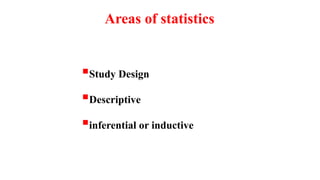





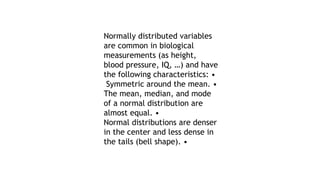


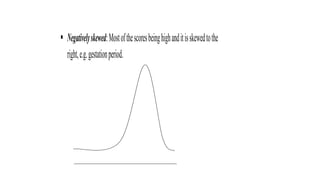
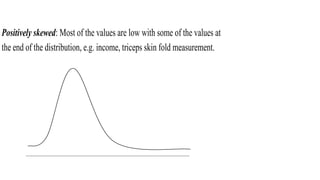
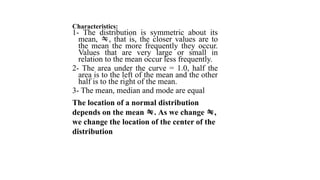
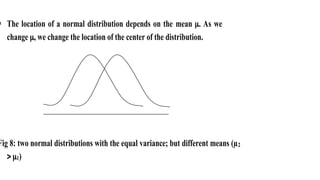
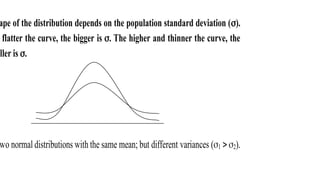

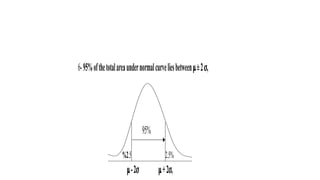
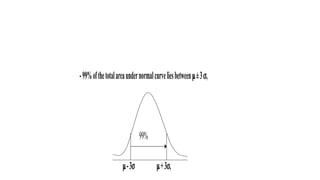

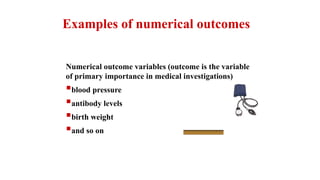


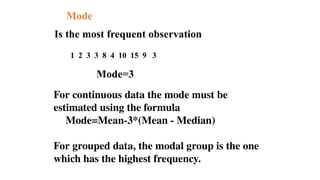




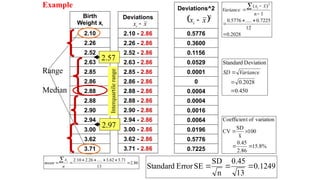
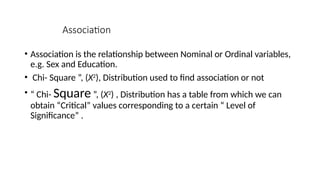

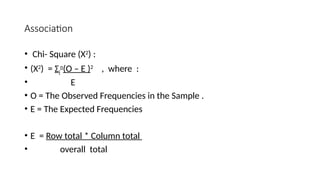

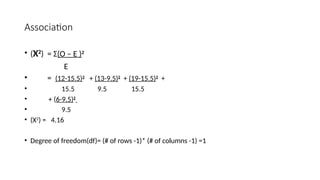

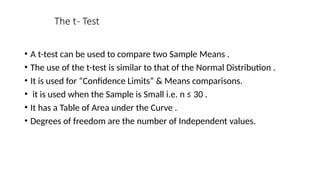

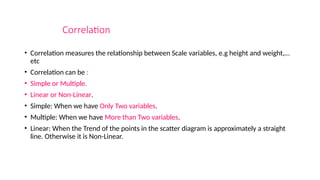

![Correlation
• The formula used to calculate “r” is given by :
• r = Σxiyi –(Σxi) (Σyi)/n
• √[Σ(xi2
) - ( Σxi)2
/n] [Σ(yi2
)- (Σyi)2
/n]](https://izqule7twkl7vq3ljkxejyz-s-a2157.bj.tsgdht.cn/biostatisticsoveralljune2024-240817130616-88e6df80/85/BIOSTATISTICS-OVERALL-JUNE-20241234567-pptx-43-320.jpg)
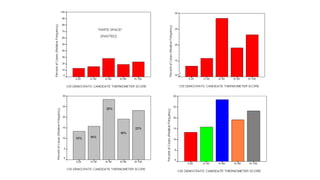



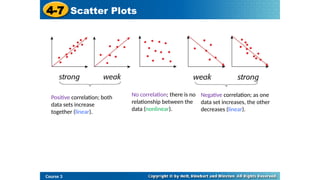

![We Approach a Continuous Density [Normal] Curve](https://izqule7twkl7vq3ljkxejyz-s-a2157.bj.tsgdht.cn/biostatisticsoveralljune2024-240817130616-88e6df80/85/BIOSTATISTICS-OVERALL-JUNE-20241234567-pptx-50-320.jpg)

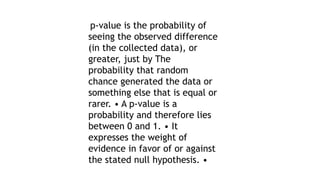
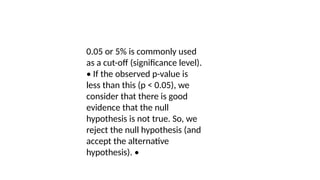

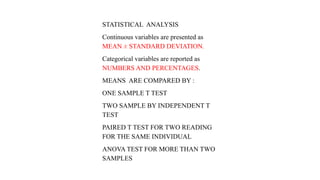

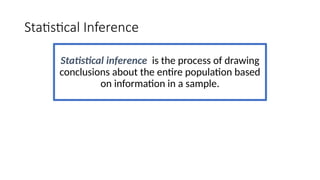
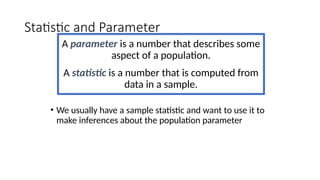



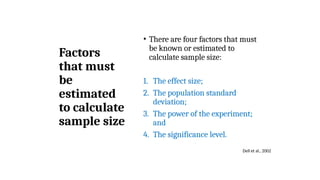
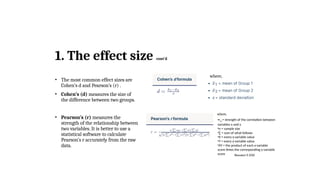


![•Type I error Alpha (α): rejecting the null
hypothesis of no effect when it is actually
true. False positive
•Type II error Beta (β): not rejecting the
null hypothesis of no effect when it is
actually false. False negative
3. The power cont’d
StatisticsHowTo.com [cited 2022 Sep 5]](https://izqule7twkl7vq3ljkxejyz-s-a2157.bj.tsgdht.cn/biostatisticsoveralljune2024-240817130616-88e6df80/85/BIOSTATISTICS-OVERALL-JUNE-20241234567-pptx-66-320.jpg)



![Sample size for dichotomous variables
cont’d.
• For dichotomous variables in a single population, the formula
for determining sample size is:
o Z = the standard normal distribution reflecting the confidence level
that will be used and it is usually set to Z = 1.96 for 95%.
o E = the desired margin of error.
o p = approximate anticipated proportion of successes in the population
and it usually ranges between 0-1. If unknown, the value 0.5 is used to
estimate the sample size. Sullivan L [cited 2022 Sep 9]](https://izqule7twkl7vq3ljkxejyz-s-a2157.bj.tsgdht.cn/biostatisticsoveralljune2024-240817130616-88e6df80/85/BIOSTATISTICS-OVERALL-JUNE-20241234567-pptx-70-320.jpg)



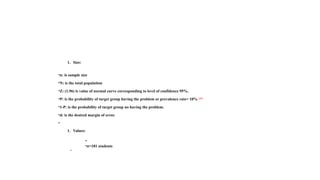



![Useful websites for sample size calculation
• ClinCalc LLC. Sample Size Calculator [website]. C2002. Available at: https://clincalc.com/stats/SampleSize.aspx
• Dean AG, Sullivan KM, Soe MM. OpenEpi: Open Source Epidemiologic Statistics for Public Health, Version.
www.OpenEpi.com, updated 2013/04/06. Available at: https://www.openepi.com
• GIGAcalculator. Power & Sample Size Calculator [website]. c2017-2022. Available at:
https://www.gigacalculator.com/calculators/power-sample-size-calculator.php
• Kohn MA, Senyak J. Sample Size Calculators [website]. UCSF CTSI. 20 December 2021. Available at
https://www.sample-size.net/
• PS: Power and Sample Size Calculation [website]. Vanderbilt Biostatistics Wiki, c2013-2022. Available from:
https://biostat.app.vumc.org/wiki/Main/PowerSampleSize.
• StatCalc in Epi Info™, Division of Health Informatics & Surveillance (DHIS), Center for Surveillance, Epidemiology &
Laboratory Services (CSELS) [website]. CDC. Available at:
https://www.cdc.gov/epiinfo/user-guide/statcalc/samplesize.html
• <http://www.biomath.info>: a simple website of the biomathematics division of the Department of Pediatrics at the
College of Physicians & Surgeons at Columbia University, which implements the equations and conditions discussed in
this article
• <http://davidmlane.com/hyperstat/power.html>: a clear and concise review of the basic principles of statistics, which
includes a discussion of sample size calculations with links to sites where actual calculations can be performed
• nQuery Advisor, SPSS, MINITAB and SAS/STAT are paid statistical programs and software that can be used both for
sample size calculations and statistical data analysis](https://izqule7twkl7vq3ljkxejyz-s-a2157.bj.tsgdht.cn/biostatisticsoveralljune2024-240817130616-88e6df80/85/BIOSTATISTICS-OVERALL-JUNE-20241234567-pptx-78-320.jpg)